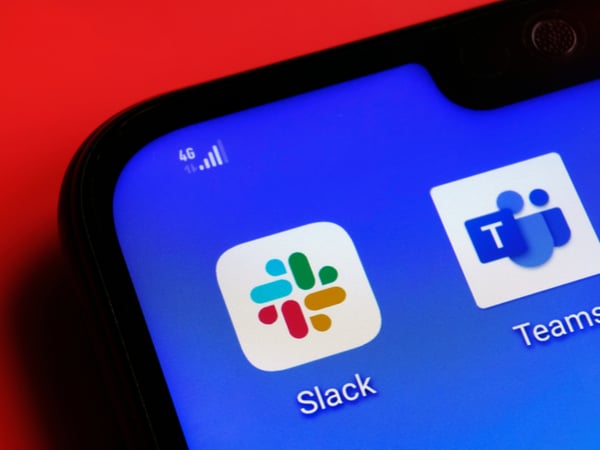Four questions to ask about your remote communication
Written by Ian MacRae Wednesday 24 November 2021
A remote-working company without healthy communication networks is just a glorified version of TaskRabbit: if every employee was working alone, completing a list of tasks with limited to no interaction with colleagues, then there would be no company culture, no bigger picture, no strategy to buy in to. Without a sense of purpose, of shared objectives and active interest in the work, productivity falls, engagement takes a dip and employees will leave the company for more fulfilling work.
Communication is not just the language people use, it’s also the tone, the frequency. The nature of the communications matters too.
Use the four prompts below to reflect on your company’s current digital communication and how your online communication channels are structured. What do you notice? Consider what changes you need to make to build a strong and healthy communications infrastructure and, in turn, a healthy and productive organisation.
1. Are communications all (or mostly) one-on-one? Do people only communicate directly with one another on email or messaging platforms?
One-on-one communication is efficient and essential. But if there are no group channels, it’s difficult to build a shared understanding and culture across teams, as well as the whole organisation. If your teams are operating in small cells that rarely interact with most other people in the organisation, then communication networks become fragmented, insular and difficult to navigate.
Make sure there are group communication channels available where larger groups can interact, get to know each other and collaborate on larger projects.
CPD: Become a communication champ
Poor communication affects productivity, engagement and retention. Whether you are working from home, in the office or in a hybrid manner, getting your message across is vital. We’ve selected just a few activities designed to help you become a Communication Champion. Complete three and receive a digital certificate.
Get started now2. Are communications platforms set up to be only work-related?
In more traditional, in-person spaces, people tend to discuss shared interests, current events outside of the company and topics that are not directly related to their work. This can help build team cohesion and bring people closer together. Make sure there are different channels for non-work discussion. Without these, some remote workers feel more isolated and disconnected from their teams and organisation.
Consider having dedicated channels for people to connect over shared interests such as sport, hobbies, pop culture discussions or out-of-work activities.
General discussions may be an afterthought, yet the type and tone of work communication shapes the culture of the workplace in fundamental ways. When there are clearly delineated channels for people to discuss things that are ‘off topic’ or outside of their specified job role, it allows employees to develop relationships that are beyond simply communication about work-based tasks.
Read next: How to do watercooler communication in a hybrid world
3. Which departments are involved in communication and how? Is communication between teams and departments focused on broadcasting information, or is it open to discussion?
Not every discussion needs to be open to general feedback. But at other times it’s valuable to open up discussions to wider groups and get a range of perspectives. HR policies, for example, affect everyone.
Making conversations (for example about HR policies) more open and inclusive helps to demystify some of the decision-making processes and helps people from different parts of the organisation to see whether their input is valued.
Be strategic here – open up the discussion when the feedback will be welcome, useful and acted on. Opening up discussions only to ignore employee’s responses does more harm than good.
4. How is feedback structured? Are all suggestions, comments and complaints directed ‘up’ or ‘down’? Is feedback primarily in one direction or are there open communication channels?
Of course managers should provide feedback, but is performance feedback welcome when it comes from employees?
Communication tends to mirror organisational structure, with communication occurring one-on-one for specific tasks, clustered into small groups or with people sorted into departments. If you’re looking to have an open culture, digital communication platforms should be structured in a way that encourages it.
Ian’s book Dark Social: Understanding the Darker Side of Work, Personality and Social Media (Bloomsbury, 2021) is out now. Keep an eye out for an upcoming article filled with specific tips to improve your digital communication skills.
Image: Shutterstock/Ascannio
You might also like these posts on this topic:
Filling in the Gaps Report
This research highlights the ongoing challenges in closing the gender pay gap.
“As managers, we can help improve the UK economy”
Simon Takel CMgr FCMI on how CMI resources help him navigate change in the further education sector
Giving Engineering Students a Competitive Edge
Discover how Newcastle College’s CMI Dual Accredited Engineering Management degree empowers future engineering leaders.
Pink suits and ice-breakers: what we learned at CMI Communities Live, Birmingham
Experts gathered in the West Midlands to share their ideas for future-proofing leadership
Don’t miss out - get notified of new content
Sign-up to become a Friend of CMI to recieve our free newsletter for a regular round-up of our latest insight and guidance.
CMI members always see more. For the widest selection of content, including CPD tools and multimedia resources, check out how to get involved with CMI membership.
Article
Our extensive range of articles are designed to keep you in the loop with all the latest management and leadership best practice, research and news.
Members See More
CMI Members have access to thousands of online learning and CPD resources. Learn more about our membership benefits
Join The Community
CMI offers a variety of flexible membership solutions, tailored to your needs. Find out more and get involved in the CMI community today.
